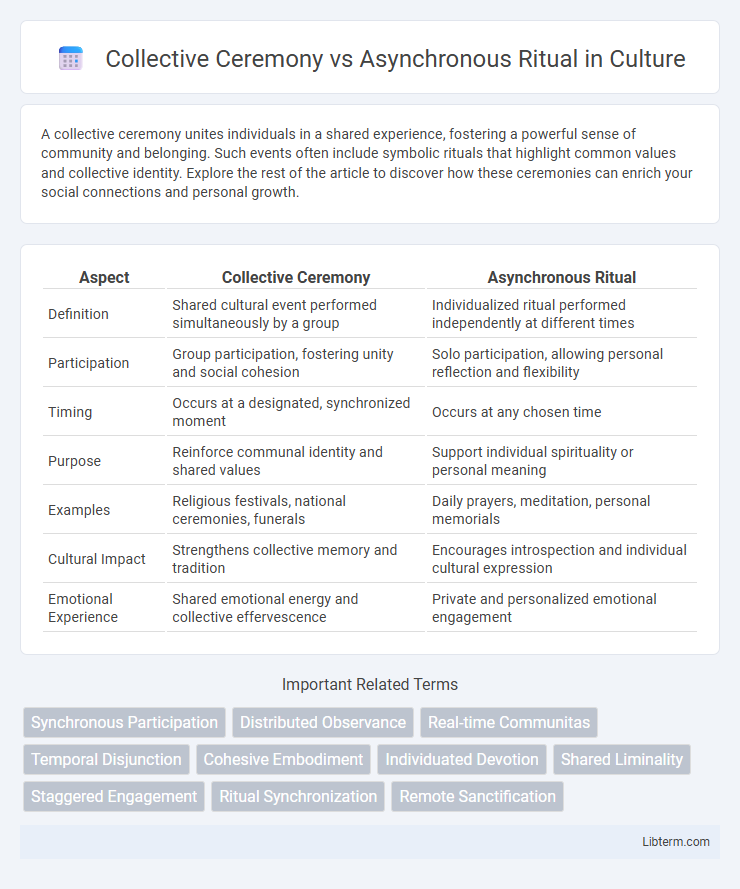A collective ceremony unites individuals in a shared experience, fostering a powerful sense of community and belonging. Such events often include symbolic rituals that highlight common values and collective identity. Explore the rest of the article to discover how these ceremonies can enrich your social connections and personal growth.
Table of Comparison
| Aspect | Collective Ceremony | Asynchronous Ritual |
|---|---|---|
| Definition | Shared cultural event performed simultaneously by a group | Individualized ritual performed independently at different times |
| Participation | Group participation, fostering unity and social cohesion | Solo participation, allowing personal reflection and flexibility |
| Timing | Occurs at a designated, synchronized moment | Occurs at any chosen time |
| Purpose | Reinforce communal identity and shared values | Support individual spirituality or personal meaning |
| Examples | Religious festivals, national ceremonies, funerals | Daily prayers, meditation, personal memorials |
| Cultural Impact | Strengthens collective memory and tradition | Encourages introspection and individual cultural expression |
| Emotional Experience | Shared emotional energy and collective effervescence | Private and personalized emotional engagement |
Understanding Collective Ceremonies
Collective ceremonies involve synchronized participation of a group in a shared space and time, fostering a strong sense of community and collective identity. These rituals reinforce social bonds through shared symbols, chants, or actions that create a unified experience. Understanding collective ceremonies highlights their role in promoting cohesion, cultural continuity, and emotional connection among participants.
Defining Asynchronous Rituals
Asynchronous rituals are practices performed individually or by separate participants at different times but connected through shared meaning and symbolic actions. Unlike collective ceremonies that require synchronous participation, asynchronous rituals allow personal reflection while maintaining a communal sense of purpose through time-shifted engagement. This flexibility in timing supports diverse contexts such as virtual memorials, online religious observances, and distributed cultural commemorations.
Historical Roots of Group Rituals
Collective ceremonies have their historical roots in ancient societies where communal participation reinforced social bonds and cultural identity during key events like harvests, religious festivals, and rites of passage. In contrast, asynchronous rituals evolved in contexts where geographic dispersion or temporal constraints made simultaneous participation impossible, allowing individuals to engage in shared practices at different times while preserving a connection to the group. Both forms reflect adaptive strategies for maintaining social cohesion through ritualistic expressions shaped by environmental and societal changes.
The Psychology of Shared Experiences
Collective ceremonies enhance social bonding by synchronizing participants' emotions and behaviors, fostering a sense of unity through real-time interaction and shared attention. Asynchronous rituals, while individually performed at different times, still promote psychological connection by invoking common symbols and meanings that reinforce group identity and continuity. Both forms activate neural pathways related to empathy and belonging, highlighting the brain's responsiveness to shared cultural practices regardless of temporal coordination.
Personalization in Private Rituals
Personalization in private rituals enhances emotional connection by tailoring practices to individual beliefs and experiences, unlike collective ceremonies that follow standardized formats. Asynchronous rituals allow participants to engage at their own pace and space, fostering intimate reflection and customization. This flexibility supports deeper personal meaning compared to the uniformity of collective ceremonies.
Social Cohesion Through Ceremony
Collective ceremonies enhance social cohesion by fostering shared experiences, synchronized actions, and communal emotions that strengthen group identity. Asynchronous rituals, while flexible, often lack the immediate, unified participation that deepens interpersonal bonds and collective solidarity. The simultaneous presence in collective ceremonies amplifies social unity through ritual synchronization and emotional resonance.
Flexibility and Accessibility of Asynchronous Practices
Asynchronous rituals provide unparalleled flexibility by allowing participants to engage at their own pace and chosen time, accommodating diverse schedules and time zones. Unlike collective ceremonies that require synchronous presence, asynchronous practices enhance accessibility for individuals with mobility challenges, remote locations, or conflicting commitments. This adaptability fosters inclusive participation, ensuring meaningful engagement without the constraints of coordinating a shared moment.
Emotional Impact: Together vs Alone
Collective ceremonies amplify emotional impact by fostering a shared sense of connection and unity among participants, enhancing feelings of belonging and communal support. Asynchronous rituals, performed alone, allow for personalized emotional processing and introspection, promoting self-awareness and individual meaning. The emotional resonance in collective settings is often intensified through group dynamics, while asynchronous rituals emphasize solitude and internal reflection.
Technological Influence on Modern Rituals
Technological advancements have transformed collective ceremonies by enabling virtual gatherings that maintain communal participation despite physical distances, enhancing inclusivity and immediacy. Asynchronous rituals, facilitated by digital platforms, allow individuals to engage in personalized symbolic acts at their convenience, often through multimedia and interactive applications that deepen personal meaning. The integration of technology reshapes traditional practices by blending collective authenticity with individual flexibility, creating dynamic, hybrid forms of modern ritual expression.
Choosing the Right Ritual for Your Community
Selecting the right ritual for your community depends on factors such as group size, cultural values, and scheduling flexibility. Collective ceremonies foster unity and shared emotional experiences through synchronized participation, ideal for tight-knit groups seeking strong social bonds. Asynchronous rituals offer inclusivity and convenience by allowing individuals to engage independently, making them suitable for dispersed or busy communities.
Collective Ceremony Infographic

 libterm.com
libterm.com